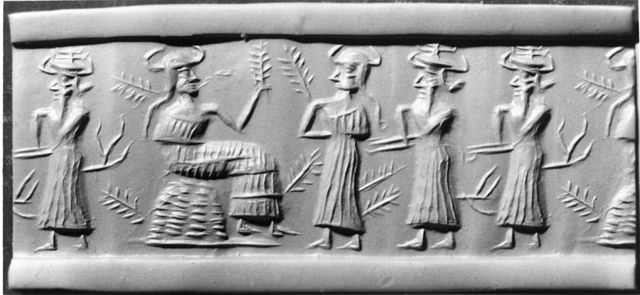
| NINHURSAG
Akkadian cylinder seal impression depicting a vegetation goddess, possibly Ninhursag, sitting on a throne surrounded by worshippers (circa 2350-2150 BC) Ninhursag also known as Damgalnuna or Ninmah, was the ancient Sumerian mother goddess of the mountains, and one of the seven great deities of Sumer. She is principally a fertility goddess. Temple hymn sources identify her as the "true and great lady of heaven" (possibly in relation to her standing on the mountain) and kings of Sumer were "nourished by Ninhursag's milk". Sometimes her hair is depicted in an omega shape and at times she wears a horned head-dress and tiered skirt, often with bow cases at her shoulders. Frequently she carries a mace or baton surmounted by an omega motif or a derivation, sometimes accompanied by a lion cub on a leash. She is the tutelary deity to several Sumerian leaders.
Names :
Nin-hursag means "lady of the sacred mountain" (from Sumerian NIN "lady" and HAR.SAG "sacred mountain, foothill", possibly a reference to the site of her temple, the E-Kur (House of mountain deeps) at Eridu. She had many names including Ninmah ("Great Queen"); Nintu ("Lady of Birth"); Mamma or Mami (mother); Aruru, Belet-Ili (lady of the gods, Akkadian).
According to legend, her name was changed from Ninmah to Ninhursag by her son Ninurta in order to commemorate his creation of the mountains. As Ninmenna, according to a Babylonian investiture ritual, she placed the golden crown on the king in the Eanna temple.
Some of the names above were once associated with independent goddesses (such as Ninmah and Ninmenna), who later became identified and merged with Ninhursag, and myths exist in which the name Ninhursag is not mentioned.
Possibly included among the original mother goddesses was Damgalnuna (great wife of the prince) or Damkina (true wife), the consort of the god Enki. The mother goddess had many epithets including shassuru or 'womb goddess', tabsut ili 'midwife of the gods', 'mother of all children' and 'mother of the gods'. In this role she is identified with Ki in the Enuma Elish. She had shrines in both Eridu and Kish.
Mythology
:
In the text 'Creator of the Hoe', she completed the birth of mankind after the heads had been uncovered by Enki's hoe.
In creation texts, Ninmah (another name for Ninhursag) acts as a midwife whilst the mother goddess Nammu makes different kinds of human individuals from lumps of clay at a feast given by Enki to celebrate the creation of humankind.
Worship
:
Her temple, the Esagila (from Sumerian E (temple) + SAG (head) + ILA (lofty)) was located on the KUR of Eridu, although she also had a temple at Kish.
Source :
https://en.wikipedia.org/ |
